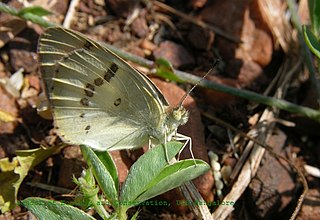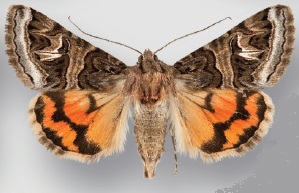
The Caspian tern is a species of tern, with a subcosmopolitan but scattered distribution. Despite its extensive range, it is monotypic of its genus, and has no accepted subspecies. The genus name is from Ancient Greek hudros, "water", and Latin progne, "swallow". The specific caspia is from Latin and, like the English name, refers to the Caspian Sea.

Otto Staudinger was a German entomologist and a natural history dealer considered one of the largest in the world specialising in the collection and sale of insects to museums, scientific institutions, and individuals.

Polyommatus is a genus of butterflies in the family Lycaenidae. Its species are found in the Palearctic realm.

Colotis, called orange tips or Arabs, is a genus of butterflies of the subfamily Pierinae found mainly in Africa and south-western Asia. The larvae of all Colotis species specialize on plants in the family Capparaceae.

Amata is an Aboriginal community in the Anangu Pitjantjatjara Yankunytjatjara Lands in South Australia, comprising one of the six main communities on "The Lands".

Argyresthia is a genus of moths in the family Argyresthiidae, previously treated as subfamily Argyresthiinae in the family Yponomeutidae.

Amata is a genus of tiger moths in the family Erebidae. The genus was erected by Johan Christian Fabricius in 1807.

Republican Party of American Samoa is the affiliate of the U.S. Republican Party in American Samoa. It is based in the territorial capital of Pago Pago.

Titanio is a genus of moths of the family Crambidae.

Drasteria is a genus of moths in the family Erebidae.

Amata kruegeri, or Ragusa's nine-spotted moth, is a moth of the family Erebidae. The species was first described by Emile Enrico Ragusa in 1904. It is found in southern and eastern Europe.

Dolbina is a genus of moths in the family Sphingidae. The genus was erected by Otto Staudinger in 1877.

Sphingulini is a tribe of moths of the family Sphingidae. The tribe was described by Walter Rothschild and Karl Jordan in 1903.

Ancylosis is a genus of snout moth. It was described by Philipp Christoph Zeller in 1839, and is known from South Africa, Uzbekistan, Spain, Turkmenistan, Lebanon, Algeria, Tunisia, Russia, Israel, Palestine, Tinos, Australia, Seychelles, Afghanistan, the United States, Iraq, Namibia, Kazakhstan, Iran, Mauritius, Mozambique, Sarepta, Argentina, Sri Lanka, and Aden.

Taenaris is a genus of butterflies in the family Nymphalidae, subfamily Amathusiinae, that distributed throughout Australasia with a majority of species being located on the island of New Guinea. They are commonly known as the owl butterflies.

Amata Catherine Coleman Radewagen, commonly called Aumua Amata, is an American Samoan politician who is the current delegate for the United States House of Representatives from American Samoa. Radewagen, a Republican, was elected on November 4, 2014, after defeating Democratic incumbent Eni Faleomavaega; she was the first-ever Republican delegate since the office had been created in 1970 and began her tenure on January 3, 2015. She also serves as the national committeewoman for the Republican Party of American Samoa. Amata is the first woman to represent American Samoa in the U.S. Congress.














